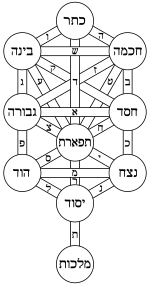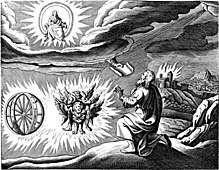梅尔卡巴神秘主义
| 犹太神秘主义系列 |
| 卡巴拉 |
|---|
 |

梅尔卡巴、默卡巴(Merkabah)或梅尔卡瓦、默卡瓦(merkavah,希伯来语:מרכבה)神秘主义(字面上的意思是战车神秘主义〔Chariot mysticism〕,中文语境更确切应译为:天车神秘主义、火战车神秘主义)是早期犹太教神秘主义的一个学派,约西元前100年至西元1000年发展而成,乃根据〈以西结书·第一章〉亦或天宫文学(hekhalot literature,英译:palaces literature)所描述的异象为教义中心,书中讲述内容是有关天上宫殿和上帝宝座的《圣经》故事。尽管对战车传统的引用也能够在后来中世纪查西迪·阿什肯纳兹(Chassidei Ashkenaz)文学中找到,但梅尔卡巴主要文学典籍却是在西元200年至700年期间形成。[1]而《天车之书》(Maaseh Merkabah,英译:Work of the Chariot)则是纪载这项传统的主要文献。[2]
词源
[编辑]merkabah(梅尔卡巴)或merkavah(梅尔卡瓦)为希伯来文拉丁化名词,英译:“thing to ride in, cart(驾乘之物,大车)”,中文可以引申为:驾乘著大车。源自辅音词根רכב r-k-b,其一般涵义为:“驾乘(to ride)”;“梅尔卡巴”一般皆作为“战车”之意。而“战车(chariot)”这词在马所拉文本(Masoretic Text)的希伯来圣经中出现44次──其多数指的是世间普通战车,[3]尽管梅尔卡巴概念与以西结的异象有关(1:4–26 (页面存档备份,存于互联网档案馆)),但这词在〈以西结书·第一章〉内容中并无明确出现。[4]
然而,若不意译,在英文语境中merkabah或merkavah(希伯来语:מֶרְכַּב、מרכבה,以及מִרְכֶּבֶת)希伯来专有名词是与异象预言中上帝的战车宝座有关。它与〈以西结书·第一章〉中由四个活物(hayyot,英译:living creatures,中译:活的生物)驱使的四轮车异象关联最密切,每个活物各有两对翅膀(或四个翅膀),[5]并且各有人、狮、牛,还有鹰(或秃鹰〔vulture〕)四张脸孔。
以西结异象中的战车
[编辑]根据〈以西结书〉的经文及其附注所述,他见到的异象是由许多天界生命体所结合的战车,且由“人的形象(Likeness of a Man)”来驱动。战车的基本结构组成主要为四个生命体。这些生命体被统称为“活物”(living creatures,希伯来文:חיות,拉丁化:hayyot或khayyot)。活物身体“如同人类(like that of a human being)”,但祂们每一个都有四张脸孔,各自对应战车能行进的四个方向(东、南、北与西)。这些脸孔分别是人、狮子、牛(后来在〈以西结书·10:14〉中变成了智天使 )还有老鹰。由于有四位天使,而每位天使又各有四张脸孔,所有总共有十六张脸孔。同时每一位活物天使也有两对翅膀。
注释
[编辑]- ^ From Apocalypticism to Merkabah Mysticism: Studies in the Slavonic, p. 224, Andrei A. Orlov (2007). However, as Gruenwald notes, the main corpus of the merkavah literature was composed in Israel in the period 200–700 CE. Some references to this tradition can be found also in the literature of German Hasidim (twelfth to thirteenth century).
- ^ Jacob Neusner (2005). Neusner on Judaism: Literature, p. 74: "When Eleazar finished the Works of the Chariot, Yohanan stood and kissed him on his head and said, Blessed is the Lord, God of Abraham. Jacob who gave to Abraham a son wise and knowing how to expound the glory of our father in heaven."
- ^ Brown; Driver; Briggs; Gesenius. Hebrew Lexicon entry for Merkabah. The Old Testament Hebrew Lexicon. 1988 [2010-10-09]. (原始内容存档于2011-09-27).
- ^ Ezekiel 1 (JPS Hebrew/English)
- ^ Six wings in Isaiah's and John's visions (Isaiah 6:2 and Revelation 4:8)
相关条目
[编辑]参考书目
[编辑] 此条目包含现处于公共领域的出版物中的内容:Singer, Isidore; et al (编). Merkabah. 犹太百科全书. New York: Funk & Wagnalls Company. 1901–1906.
此条目包含现处于公共领域的出版物中的内容:Singer, Isidore; et al (编). Merkabah. 犹太百科全书. New York: Funk & Wagnalls Company. 1901–1906.
- Kohler, Kaufmann. "Merkabah" (页面存档备份,存于互联网档案馆) at JewishEncyclopedia.com
- Scholem, Gershom G. Jewish Gnosticism, Merkabah Mysticism, and Talmudic Tradition
- Dennis, Geoffrey. The Encyclopedia of Jewish Myth, Magic, and Mysticism (Llewellyn Worldwide, 2007)
- Dennis, Geoffrey, "Water as a Medium for Altered States of Consciousness in Early Jewish Mysticism", Anthropology of Consciousness Vol. 19, No. 1, (2008).
- Jacobs, Joseph and A. Biram Ma'aseh Bereshit; Ma'aseh Merkabah (页面存档备份,存于互联网档案馆) at JewishEncyclopedia.com
- Karr, Don. Notes on the Study of Merkabah Mysticism and Hekhalot Literature in English (页面存档备份,存于互联网档案馆)
- Scholem, Gershom. Origins of the Kabbalah, ISBN 0-691-02047-7.
- Elior, Rachel, The Three Temples, ISBN 978-1-904113-33-1.
